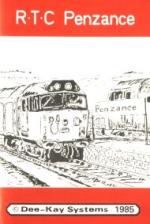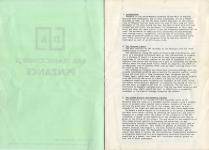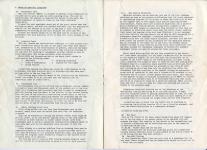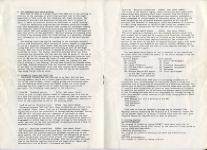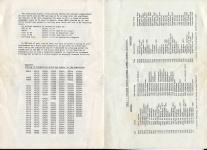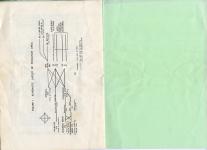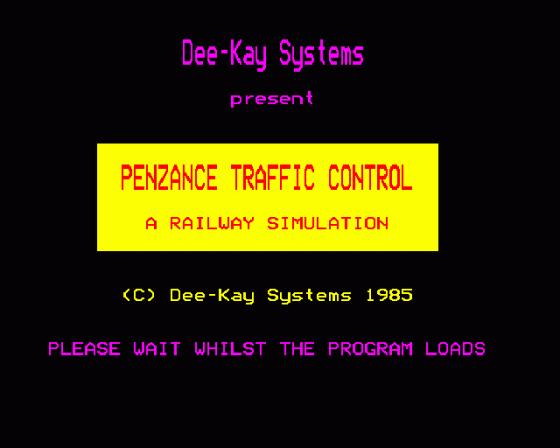
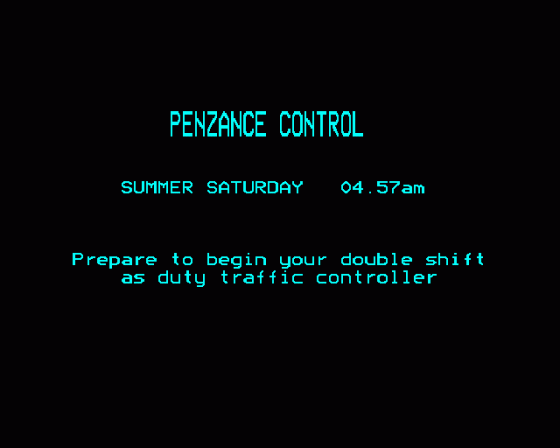
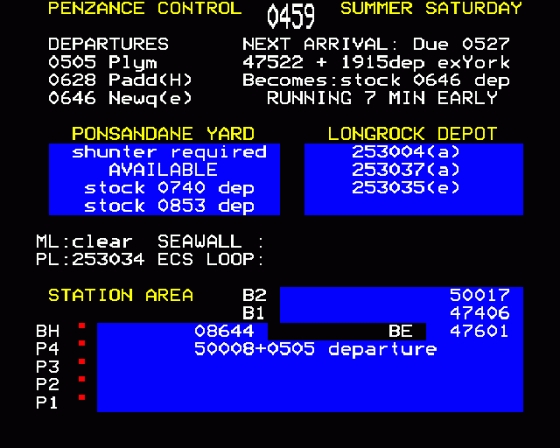

| Genre: | Game: Simulation |
| Publisher: | Deekay |
| Cover Art Language: | English |
| Machine Compatibility: | BBC Model B |
| Release: | Professionally released on Cassette |
| Available For: | BBC Model B & Spectrum 48K |
| Compatible Emulators: | BeebEm (PC (Windows)) PcBBC (PC (MS-DOS)) Model B Emulator (PC (Windows)) |
| Original Release Date: | 1st January 1985 |
| Original Release Price: | £7.50 |
| Market Valuation: | £2.50 (How Is This Calculated?) |
| Item Weight: | 64g |
| Box Type: | Cassette Single Plastic Clear |
| Author(s): | - |
Variant Items
There are 0 other items featuring this same game (that we know about!). Click any of them for their details.
Active Auctions
Closed Auctions
Buy It
Unfortunately no-one is currently selling this item.
Auction Price Watch
Worried you're being ripped off? Closing prices on eBay can help you decide what a reasonable price is for a particular item.
Full Instructions
Introduction
Penzance is the south-western termninus of the West of England mainline from Paddington and, in this simulation, set on a Summer Saturday in 1984, you are the Duty Traffic Assistant in the control room on Penzance station, faced with the task of directing all train movements in the area during the day. You have to deal with arriving locomotives and stock, the assignment of locomotives to their next duty, and above all must strive to get the scheduled departures off on time.
The situation is complicated by additional holiday workings, late-running trains, locomotives needing fuel or attention, and a shortage of platform space at peak times, and to make matters worse your every instruction is being monitored by Regional Control at Paddington as part of an efficiency study.
The Penzance Layout
The main features of the railways in the Penzance area are shown schematically in Figure 1.
The approach is along the shore of Mount's Bay from Marazion, and there is a potential bottleneck here in that the mainline is singled for a distance of about 1.5 miles as it runs from Longrock to the beginnings of the station complex at the base of Chyandour Cliff. An adjacent line serves as the coaching stock yard at Ponsandane and the new service depot for High Speed Trains (HSTs) at Longrock, and there is an additional loop at Eastern Green used by empty coaching stock (ecs) en route to the station.
The terminus at Penzance has three main covered platforms, with an outside subsidiary platform used primarily for parcels traffic, relief trains and stock with a long turnaround time. Alongside are the 'flower bays', which take their name from the heavy springtime traffic from the Scillies but which in summer are used as the principal locomotive stabling area following the severance of the lines to the old diesel fuelling point adjacent (locomotives now having to trip to the HST depot at Longrock for fuel or attention).
The bay area is controlled by manually operated points from the bay head reception and departure line, which itself has what is effectively a locomotive headshunt in the form of sidings alongside the seawall.
The Screen Display And Movement Control
The locations of all locomotives and available stock in the Penzance area are shown on a movement control console, with a display which is automatically updated once a minute. Details of the next arrival are given near the top of the screen, and there is also a reminder of the times and destinations of the next three departures.
To obtain a status report on a locomotive or to direct a movement you must first obtain control by pressing the space bar, and then in response to a prompt enter the number of the locomotive or HST set concerned. A report on the condition of the locomotive will theen be given at the bottom of the screen. You may return to the simulation at this stage without penalty by pressing the Return key, or may alternatively initiate a movement by entering the two letter code of the desired new location. This should, in general, be adjacent to the present location (See Figure 1, the main exception being certain through movements past the Ponsandane line hold position), and of course have space to accept the new locomotive.
Inadmissible movements or movements which conflict with previously initiated directives are signified by a buzzer, and these will contribute penalty points to your end of shift assessment.
Notes On Specific Locations
PY Ponsandane Yard
Only the shunter (08644) is allowed to marshal train formations in the yard and to work in and out with coaching stock. You will be notiied when the shunter is required for duties in the yard, and should endeavour to return it there at the first available opportunity.
To move the next available stock out of the yard, ensure that the ecs loop is empty, and with the shunter available type the destination code EL (If the shunter is at work in the yard it must first be summoned by re-entering as the next location the yard code PY).
To move the shunter alone out of the yard type PL to move to the Ponsandane line hold position, or EL to back onto stock already in the ecs loop.
LD Longrock Depot
HSTs are cleaned and serviced here overnight in a new purpose-built shed. Locomotives should be sent to the depot only when they require fuel, examination or the rectification of defects, and with the depot capacity being limited to just four units they should be returned to the bay area for stabling or assignment to other duties as soon as practicable when they become available after attention.
Whilst HSTs and locomotives are on the depot, their status is indicated by the following codes:
a - available
e - Class A examination
f - being fuelled
r - receiving attention
s - stabled for the night
Locomotives leaving the depot may travel as light engines to the Ponsandane line hold position (PL), or alternatively may back onto waiting stock in the ecs loop (EL).
HSTs running empty from the depot to the station area can similarly travel via either PL or EL provided that the desired line is completely clear of other traffic.
PL Ponsandane Line
The Ponsandane line is the service line linking the station complex to Longrock depot and Ponsandane yard. At the western end of the line, there is a locomotive hold position, and this is used by locomotives and HSTs running from the depot to the station, by the shunter moving from the yard to the station or manoeuvring around stock in the ecs loop, and by locomotives shuttling between the platforms and the bay head. The hold position need not be specified as an intermediate destination if the final destination is either LD, PY or EL from the station area, or one of the platforms from the ecs loop.
EL Empty coaching stock loop
After being pulled into the loop from Ponsandane yard by the shunter, empty stock must be backed from here into its departure platform.
This can be achieved by running the shunter around first (type RR with PL clear), or by the shunter leaving stock in the loop (type PL to move on to other duties) to either itself return later from Ponsandane yard or allow a locomotive released from Longrock depot to come onto what will be its departure stock and back it into the station.
Stock already in a station platform from an incoming train may be temporarily moved to the ecs loop by the shunter, provided there is more than 20 minutes to its scheduled departure time, this manoeuvre allowing the original train locomotive trapped at the buffers to be released early if so desired.
The loop may also be used by HSTs running between Longrock depot and the station as an alternative to going via the PL hold position.
P1-4 The Station Platforms
Mainline arrivals can be directed into one of the four terminus platforms as soon as you receive notification that the train concerned is approaching Longrock (If no action is taken, the train will be held at the signals east of the single track section awaiting further instructions).
Trains which are locomotive-hauled may use a platform with a locomotive from an earlier arrival still trapped at the buffers, but HSTs require a completely free platform so that they can be coupled to electrical short lines near the buffer stops, enabling their power car engines to be shut down (Platform 4 is not equipped with this facility and thus should not be used by HSTs scheduled for a subsequent departure working).
Locomotive-hauled trains will automatically have the train engine uncoupled, and when this has been done either the shunter or the locomotive for the departure working may be attched to the other end of the train. No attempt should however be made to move recently arrived stock until sufficient time has been allowed for unloading (typically 10 minutes for standard passenger trains and up to 30 minutes for other workings).
Empty stock arriving from the ecs loop propelled by the shunter will have 08644 uncoupled, but any other locomotive will be retained as the departure engine. In each case, up to two locomotives can be trapped at the buffer stops by the coaching stock, but HSTs coming into a platform from Longrock depot to form the next HST working from Penzance require a completely empty platform (and as mentioned above preferably not P4).
Locomotives are attached to the stock of their next working by directing them into the platform from either the Ponsandane line hold position or the seawall sidings as appropriate. A prime rule of operation is that, once a locomotive is attached to the departure end of a train, it must depart with that train. This applies to the shunter as well as mainline locomotives, or if 08644 is coupled to ecs, its next movement must be to Ponsandane Yard with that stock, and if it is coupled to stock for a departure working, 08644 can only move the stock to the ecs loop for temporary stabling and eventual return to the platform area.
Departures should be directed out of the platforms at the appropriate time by specifying ML as the next location. A high priority should be given to getting departures away on time, but this of course may not be possible if the train is still loading or if an incoming train is occupying the single track section from Longrock.
Locomotives may be moved from the buffer end of platforms by re-entering the platform location (P1-4) as a direction movement, and then the onward destination in a subsequent movement.
Locomotive Stabling Areas
BH Bay Head
This is the throat of the bays, where locomotives pause for signals out of the bay area or for manual points to be operated into and between the bays. The capacity of the throat is two locomotives, and if desired locomotives may be moved from one slot to the other by re-entering the BH code.
B1,B2,BE Flower Bays and the Bay End
These locations are the principal stabling points for locomotives between duties. Motorail stock is also parked at the end of either B1 or B2 during the day (see next section).
SW Sea Wall Sidings
In this simulation, these lines are only used as a headshunt for the bay head, where locomotives may be temporarily parked on a last one in/first one out basis.
The Timetable And Stock Working
Your turn of duty is a double shift from 0500 hrs in the morning to 2100 hrs in the evening, at which time you hand over to the night supervisor to deal with the few remaining late night arrivals. The schedule of arrivals and departures during your shift is given in Table 1, where an asterisk denotes an additional or relief working.
Stock for departures originating from Penzance should be brought down from Ponsandane with adequate time allowed for passenger loading (the departure time of coaching stock being labelled in Ponsandane (the departure time of coaching stock being labelled in Ponsandane yard, whilse HSTs are automatically assigned to the next HST departure when they arrive in the platforms). The next working of incoming stock is shown a few minutes after the train arrives in a platform, although this information is of course also given earlier in the next arrival slot.
One working requiring special handling is the overnight motorail service from Paddington, which because of traffic demand is diagrammed to run as a separate train rather than the more normal practice of coming down with the newspapers and returning as part of the Night Riviera. When the train arrives, it should be directed into one of the platforms as usual. The shunter should be attached after the train locomotive has uncoupled, and the vans may then be moved to the end of either B1 or B2 for unloading by typing the appropriate location code with PL, BH and the chosen bay clear of other traffic. The motorail vans are left in the bay during the day ready for loading for the return working in the evening, and may have locomotives stabled along with them. Towards departure time the selected train locomotive should be put next to the motorail stock, and then coupled up by typing the special code MR. Departure is directly from the bay at the appointed time using the ML code as usual.
Locomotive Types And Their Use
Individual locomotives are referred to by their British Rail running numbers, which are a coded classification with the first two- (or in the case of HSTs, three-) digits, giving the locomotive class and the remaining three digits the number within the class (with sometimes the most significant of these denoting a particular subclass). The following types appear in the simulation:
Class 08 Standard shunter 350hp (max speed 15mph)
There is just a single shunter based at Penzance, and this acts as both yard and station pilot. During the summer of 1984, the shunter was 08644 and was adorned with unofficial 'Debbie' nameplates, rumoured to refer to the ladyfriend of one of the shunting staff.
Class 45 and 46 Mainline locos 2500hp (max speed 90mph)
Introduced between 1960 and 1963, these locomotives are derived from the original 'Peak' class. They are all Midland and Eastern region engines which reach the south-west on through holiday workings. During 1984, the 45/1 subclass were the commonest of the Peaks on these trains, with indeed Class 46s quite rare as the class was run down prior to withdrawal at the end of the year. The locomotives should be diagrammed to return home on the through workings to the midlands and north, and only in the most exceptional circumstances should a Peak be allocated to a Paddington train.
Class 47 Mainline locomotives 2580hp (max speed 95mph)
The veritable workhorses of British Rail, the 47/4 subclass (numbers 47401-617) are the standard mainline passenger locomotives of the whole system. The 47/0 subclass (47001-299) are designated as mixed traffic locomotives, and are often pressed into summer passenger service on reliefs and holiday workings. Most are un-named, although some of the Western regions allocation are named after famous GWR personalities such as Brunel, Churchward and Gooch.
Class 50 Mainline locomotives 2700hp (max speed 100mph)
The pride of the Western region, these locomotives were named after famous Royal Navy warships after their transfer from the Midland region in the mid 1970s. The locomotives have recently undergone a major programme of refurbishment at Doncaster works, and as the top rank locomotives are allocated whenever possible on all non-HST services from Penzance to Paddington. 50007 was somewhat of a novelty in 1984, being repainted in imitation GWR livery and renamed 'Sir Edward Elgar' in preparation for the GWR 150 year celebrations.
Class 253 High Speed Trains 4500hp (max speed 125mph)
The units working to Penzance are the standard Western region sets with a power car at each end of a seven coach formation. Although the high speed of the units can only be utilized at the Paddington end of the line, these trains have improved enormously the standard of service on the whole of the West of England mainline. Split into three groups, 253001-18 and 253028-40 are used on internal Western region services, whilst 253041-55 are used in inter-regional workings to the north east and north west.
The home maintenance depots of the locomotives in the simulation are given after the locomotive number in the status message using the following standard codes:
Western Region
BR - Bristol
CF - Cardiff
LA - Laira (Plymouth)
OC - Old Oak Common (London)
PZ - Penzance
WR - Western Region HST depots at Old Oak, Laira and St. Phillip's Marsh (Bristol)
Other Regions
BS - Bescot (Birmingham)
CD - Crewe
GD - Gateshead (Newcastle)
HA - Haymarket (Edinburgh)
IM - Immingham
TO - Toton (Nottingham)
You have a relatively free hand in allocating locomotives to trains, but only in exceptional circumstances should a locomotive requiring fuel or attention be dispatched on a departure working. You should keep in mind the comments on locomotive usage made earlier, and if possible give locomotives at least an hour turnaround at Penzance. In addition, you should try to allocate non-Western region locomotives to the following workings which are diagrammed for through haulage to their destinations (other services to the north changing motive power at Birmingham):
| 0646 | Newquay ecs (for a working to the NE) |
| 0853 | Newcastle |
| 1125 | Manchester |
| 1600 | Derby |
From time to time an emergency message may be received from Regional Control, requesting the dispatch of a locomotive, either for use at another depot or to assist a failed train down the line. Such requests should be complied with as soon as possible.
Getting Started
The simulation starts a few minutes before the nominal commencement of your shift with an HST waiting in PL to come into the platforms, the shunter in BH (but requested for work in PY), a Class 50 hauled passenger train in P4 soon to depart, three HSTs stabled at LD, and three locomotives parked in the bay area (with the one in BE requiring fuel).
An initial sequence of movements might be:
| HST in PL | direct to P1 |
| 08644 | direct to PY (now PL is clear) |
| Loco in P4 | direct to ML at departure time |
| Loco in BE | direct to BH, and then to LD |
| Arriving loco | direct to P3 as approaches Longrock |
At the end of your turn of duty you will be given a rating of your performance on a scale up to excellent. If you wish to finish your shift early, the simuation may be terminated by pressing either the ESCAPE key (BBC), Q (Spectrum/Commodore 64), but if only a temporary respite is required, we recommend freezing the action on a status report or movement command directive.
Appendix: Listing Of Locomotives Which May Appear In The Simulation
| 08644 | 45124 | 47029 | 47522 | 50016 | 50046 | 253034 |
| 45125 | 47076 | 47534 | 50017 | 50047 | 253035 | |
| 45126 | 47078 | 47537 | 50018 | 50048 | 253036 | |
| 45046 | 45127 | 47079 | 47556 | 50019 | 50049 | 253037 |
| 45057 | 45128 | 47086 | 47557 | 50020 | 50050 | 253038 |
| 45129 | 47091 | 47558 | 50021 | 253039 | ||
| 45130 | 47096 | 47559 | 50022 | 253001 | 253040 | |
| 45101 | 45131 | 47104 | 47560 | 50023 | 253002 | 253041 |
| 45102 | 45132 | 47123 | 47588 | 50024 | 253003 | 253042 |
| 45103 | 45133 | 47159 | 47599 | 50025 | 253004 | 253043 |
| 45104 | 45134 | 47186 | 47600 | 50026 | 253005 | 253044 |
| 45105 | 45135 | 47273 | 47601 | 50027 | 253006 | 253045 |
| 45106 | 45136 | 47602 | 50028 | 253007 | 253046 | |
| 45107 | 45137 | 47406 | 47608 | 50029 | 253008 | 253047 |
| 45108 | 45138 | 47421 | 50030 | 253009 | 253048 | |
| 45109 | 45139 | 47435 | 50001 | 50031 | 253010 | 253049 |
| 45110 | 45140 | 47451 | 50002 | 50032 | 253011 | 253050 |
| 45111 | 45141 | 47459 | 50003 | 50033 | 253012 | 253051 |
| 45112 | 45142 | 47474 | 50004 | 50034 | 253013 | 253052 |
| 45113 | 45143 | 47500 | 50005 | 50035 | 253014 | 253053 |
| 45114 | 45144 | 47501 | 50006 | 50036 | 253015 | 253054 |
| 45115 | 45145 | 47502 | 50007 | 50037 | 253016 | 253055 |
| 45116 | 45146 | 47507 | 50008 | 50038 | 253017 | |
| 45117 | 45147 | 47508 | 50009 | 50039 | 253018 | |
| 45118 | 45148 | 47509 | 50010 | 50040 | 253028 | |
| 45119 | 45149 | 47510 | 50011 | 50041 | 253029 | |
| 45120 | 45150 | 47511 | 50012 | 50042 | 253030 | |
| 45121 | 47512 | 50013 | 50043 | 253031 | ||
| 45122 | 46026 | 47513 | 50014 | 50044 | 253032 | |
| 45123 | 46052 | 47514 | 50015 | 50045 | 253033 |
Table 1: Penzance Traffic Workings (Summer Saturday 0500-2100)
Arrivals
| Due | Train | Next Working | |
|---|---|---|---|
| 0527 | * | 1915 ex York | 0646 departure (ecs Newquay) |
| 0544 | Plymouth (parcels) | ecs Ponsandane | |
| 0625 | Paddington (mail) | ecs Ponsandane | |
| 0654 | Paddington (newspapers) | ecs Ponsandane | |
| 0710 | * | Paddington (motorail) | Bays for unloading |
| 0748 | Night Riviera (sleeper) | ecs Ponsandane | |
| 0805 | 2357 ex Paddington | 0932 departure (Paddington) | |
| 0843 | 2217 ex Manchester | 1125 departure (Manchester) | |
| 0901 | 2315 ex Liverpool | 1035 departure (Leeds) | |
| 1029 | 0825 ex Plymouth | 1105 departure (Paddington) | |
| 1133 | Paddington (parcels) | ecs Ponsandane | |
| 1200 | 0630 ex Worcester (HST) | 1235 departure (Paddington) | |
| 1243 | * | 0751 ex Bristol (ecs) | 1415 departure (Wolverhampton) |
| 1307 | 0745 ex Paddington (HST) | 1340 departure (Paddington) | |
| 1317 | * | 0621 ex Wolverhampton | 1520 departure (Wolverhampton) |
| 1358 | 0845 ex Paddington (HST) | 1448 departure (Paddington) | |
| 1433 | 0750 ex Swansea | 1540 departure (Paddington) | |
| 1456 | 0717 ex Derby | 1600 departure (Derby) | |
| 1528 | 0940 ex Paddington | 1615 departure (Paddington) | |
| 1548 | 1045 ex Paddington (HST) | 1700 departure (Paddington) | |
| 1642 | Cornish Riviera (HST) | ecs Longrock Depot | |
| 1709 | 0914 ex Brighton | ecs Ponsandane | |
| 1753 | 0936 ex Liverpool | ecs Ponsandane | |
| 1804 | 1245 ex Paddington (HST) | ecs Longrock Depot | |
| 1824 | 0921 ex Leeds | ecs Ponsandane | |
| 1919 | * | 1330 ex Paddington (relief) | ecs Ponsandane |
| 1929 | 1210 ex Liverpool (HST) | 2013 departure (ecs Plymouth Laira) | |
| 1946 | 0922 ex Newcastle | ecs Ponsandane | |
| 2010 | 1345 ex Paddington | ecs Ponsandane | |
| 2042 | 1445 ex Paddington | ecs Ponsandane | |
| 2101 | 1545 ex Paddington (HST) | ecs Longrock Depot |
* Denotes additional train to the normal working timetable
Departures
| Time | Train | Next Working | |
|---|---|---|---|
| 0505 | Plymouth | Ponsandane Yard | |
| 0628 | Paddington (HST) | Longrock Depot | |
| 0646 | +* | Newquay (ecs) | 0527 arrival |
| 0725 | Paddington (HST) | Longrock Depot | |
| 0740 | Glasgow | Ponsandane Yard | |
| 0835 | Paddington (HST) | Longrock Depot | |
| 0853 | + | Newcastle | Ponsandane Yard |
| 0910 | Leeds | Ponsandane Yard | |
| 0932 | Paddington | 0805 arrival | |
| 1000 | Liverpool | Ponsandane Yard | |
| 1020 | Paddington (HST) | Longrock Depot | |
| 1035 | Leeds | 0901 arrival | |
| 1050 | Brighton | Ponsandane Yard | |
| 1105 | Paddington | 1029 arrival | |
| 1125 | + | Manchester | 0843 arrival |
| 1235 | Paddington (HST) | 1200 arrival | |
| 1340 | Paddington (HST) | 1307 arrival | |
| 1350 | Bristol (parcels) | Ponsandane Yard | |
| 1415 | * | Wolverhampton (relief) | 1243 arrival |
| 1436 | Paddington (relief) | Ponsandane Yard | |
| 1448 | Paddington (HST) | 1358 arrival | |
| 1520 | * | Wolverhampton | 1317 arrival |
| 1540 | Paddington | 1433 arrival | |
| 1600 | + | Derby | 1456 arrival |
| 1615 | Paddington | 1528 arrival | |
| 1700 | Paddington (HST) | 1548 arrival | |
| 1815 | Plymouth | Ponsandane Yard | |
| 1921 | * | Paddington (motorail) | Loading in bays |
| 2013 | Plymouth Laira (HST ecs) | 1929 arrival | |
| 2030 | * | Paddington (relief) | Ponsandane Yard |
| 2045 | Night Riviera (sleeper) | Ponsandane Yard |
+ Denotes trains diagrammed for non-WR motive power
Loading
BBC:
CHAIN"" (RETURN)
Note: Users with disc interfaces should first return to the cassette filing system by typing *TAPE and PAGE=&E00).
Commodore 64:
The program is loaded by pressing the SHIFT and RUN/STOP keys together.
Spectrum:
LOAD"" (ENTER)
Screen Designers
The following utilities are also available to allow you to edit the supplied screens of this game:
Cheats
Download
A digital version of this item can be downloaded right here at Everygamegoing (All our downloads are in .zip format).
| Download | What It Contains |
|---|---|
| A digital version of RTC Penzance suitable for BeebEm (PC (Windows)), PcBBC (PC (MS-DOS)), Model B Emulator (PC (Windows)) |
Report A Problem
We thank you from the bottom of our hearts if you report something wrong on our site. It's the only way we can fix any problems!
You are not currently logged in so your report will be anonymous.
Add Note
Release Country
Change the country to update it. Click outside of this pop-up to cancel.
Scan Of Selected Article
If you auction an item, it will no longer show in the regular shop section of the site.

